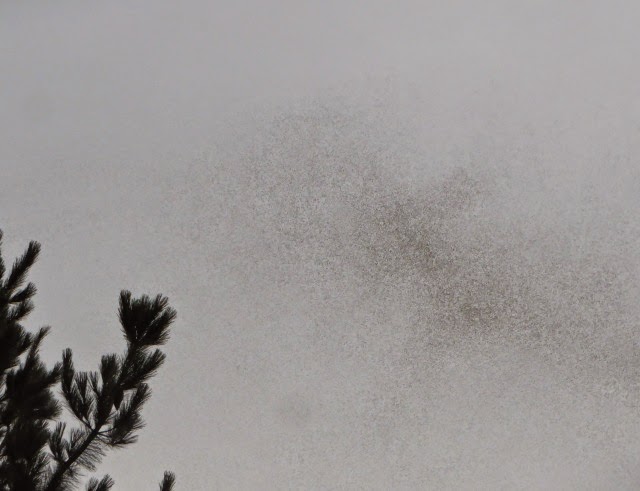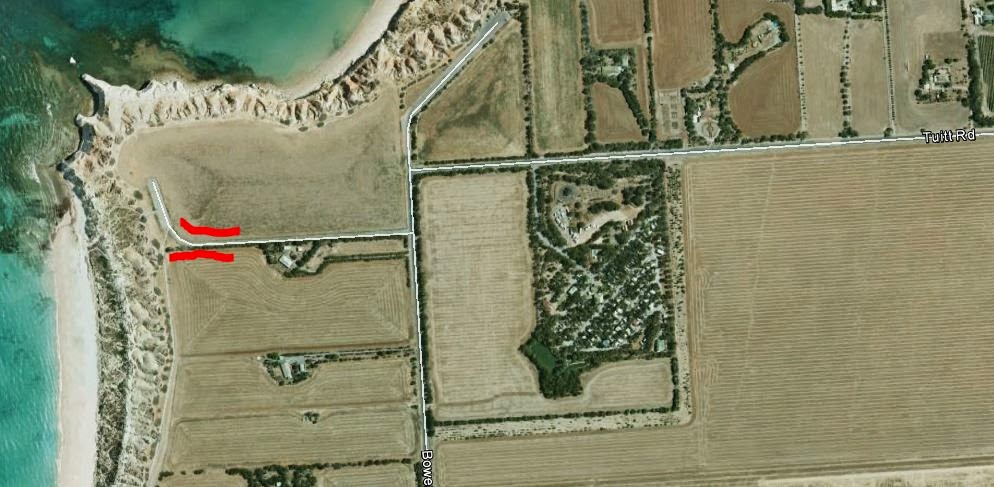ANPS Outing to Mr Corree and rocky surrounds
I have used the word outing as this was pretty much of a drive by rather than a walk.
After gathering in Weston and fitting everybody into 5 cars (2 Subarus and 3 big fat Toyotas) we headed off to Piccadilly Circus - in the Brindabellas not the neonified thoroughfare in London. There we were greeted by fog,
It was noted that the external temperature was a measly 11 degrees C. OK, it is Autumn but that is rather cool: fleeces and parkas tended to appear.
After a stop for morning tea we drove along Two Sticks Rd towards Mount Coree. This a very well known, but not that often visited, part of the Brindabellas since the peak is dominant on the Canberra skyline. It also marks the point at which the border of the ACT ceases to be a straight line (NE/SW) and follows the ridgeline of the Brindabellas more or less South. We were approaching from behind the Range, and were thus in Brindabella NP in NSW.
The first driving challenge was a very large pughole in the road. Being charitable one could say it was an after effect of the rain. Being honest one could say it was evidence that the road hadn't been visited by a grader for some months. The image (taken by Frances) shows the hole being navigated on the way down.
A few more holes were found as we went up and the road got progressively rockier. At the top I stalled (Subarus have neither as much power as a Landcruiser nor as low a bottom gear) and the passengers debouched while I got going again. (I suspect this was more a mental thing for me - no need to worry about other people getting bounced around - rather than a dramatic change to the power:weight ratio.)
The views from the top were spectacular.
The rock was also attractive close-up!
Despite the somewhat extreme climate faced in the area (at 1295m the summit is a good bit higher than anything else nearby, in most directions) and having been blasted by the 2003 bushfires there was still a good bit of vegetation cover. The most attractive flowers were on a Leptospermum micromyrtus cowering in a fissure between two rocky outcrops.
Evidence of flowering by Oxylobium ellipticum was also quite attractive in a past-it sort of way.
Getting back down the track was very straightforward and we stopped for lunch at a camp ground. Several interesting looking fungi were growing here. The first is in the Russula clelandii group (which includes R. lenkunya) - thank you Fungimap; then Amanita xanthocephala and Oudemansiella radicata.
This was where I located our second orchid species for the day. This was Parson's Bands Eriochilus cuculata. (The first species was a hyacinth orchid seen beside the track as we drove along.)
We then swung on to Bald Mountain Track. From what we encountered along here the word "Goat" could well be inserted before the word "Track". It was about the limit of my skills at Subaru driving, since the surface of the road was effectively a steep scree slope in places, but the passengers only had to hop out one more time. The forest - often dominated by Brown Barrel (Eucalyptus fastigata) traversed by this bush trail were very attractive.
This part of the trip was well supplied with "damp gully birds". We saw a Satin Flycatcher, Eastern Yellow Robin, several species of Honeyeater and heard a Red-browed Treecreeper. This stop also featured a great display of Derwentia tasmanicus fruit. (image by Frances)
At our final stop, in a rather heathy area, I found the first flowering pea (ie legume) of the trip.
I hate to devalue the word 'spiffy' but that is a really nicely designed flower.
Insects were relatively few and far between - possibly reflecting the cool temperatures (see below). I thought I was going to get a nice shot of a weevil, but my camera strap swung round and knocked it away! This caterpillar seemed more resilient. I think it is a Hawk moth of the family Sphingidae.
After all the excitement, as we were leaving the forest - which we thought rather warm by now - my car thermometer was showing the external temperature as 13 degrees. Since the 4 of us in the car all thought it rather warm outside at least 2 of us (Frances and I) decided that a flying rock - of which there had been plenty - had massacred the temperature sensor, which resides somewhere in a wheel arch. The CBs were called into play, and the leading Toyota reported 14 degrees which I thought close enough to 13 degrees. Once we got out of the forest and down on the plains, the therms rose rapidly to 24. I presume the forest must have been trapping a layer of cool air at ground level: this reminded me of a display in the Rain forest gully at ANBG showing how the dense cover cools the soil..
After gathering in Weston and fitting everybody into 5 cars (2 Subarus and 3 big fat Toyotas) we headed off to Piccadilly Circus - in the Brindabellas not the neonified thoroughfare in London. There we were greeted by fog,
It was noted that the external temperature was a measly 11 degrees C. OK, it is Autumn but that is rather cool: fleeces and parkas tended to appear.
After a stop for morning tea we drove along Two Sticks Rd towards Mount Coree. This a very well known, but not that often visited, part of the Brindabellas since the peak is dominant on the Canberra skyline. It also marks the point at which the border of the ACT ceases to be a straight line (NE/SW) and follows the ridgeline of the Brindabellas more or less South. We were approaching from behind the Range, and were thus in Brindabella NP in NSW.
The first driving challenge was a very large pughole in the road. Being charitable one could say it was an after effect of the rain. Being honest one could say it was evidence that the road hadn't been visited by a grader for some months. The image (taken by Frances) shows the hole being navigated on the way down.
A few more holes were found as we went up and the road got progressively rockier. At the top I stalled (Subarus have neither as much power as a Landcruiser nor as low a bottom gear) and the passengers debouched while I got going again. (I suspect this was more a mental thing for me - no need to worry about other people getting bounced around - rather than a dramatic change to the power:weight ratio.)
The views from the top were spectacular.
The rock was also attractive close-up!
Despite the somewhat extreme climate faced in the area (at 1295m the summit is a good bit higher than anything else nearby, in most directions) and having been blasted by the 2003 bushfires there was still a good bit of vegetation cover. The most attractive flowers were on a Leptospermum micromyrtus cowering in a fissure between two rocky outcrops.
Evidence of flowering by Oxylobium ellipticum was also quite attractive in a past-it sort of way.
Getting back down the track was very straightforward and we stopped for lunch at a camp ground. Several interesting looking fungi were growing here. The first is in the Russula clelandii group (which includes R. lenkunya) - thank you Fungimap; then Amanita xanthocephala and Oudemansiella radicata.
This was where I located our second orchid species for the day. This was Parson's Bands Eriochilus cuculata. (The first species was a hyacinth orchid seen beside the track as we drove along.)
We then swung on to Bald Mountain Track. From what we encountered along here the word "Goat" could well be inserted before the word "Track". It was about the limit of my skills at Subaru driving, since the surface of the road was effectively a steep scree slope in places, but the passengers only had to hop out one more time. The forest - often dominated by Brown Barrel (Eucalyptus fastigata) traversed by this bush trail were very attractive.
This part of the trip was well supplied with "damp gully birds". We saw a Satin Flycatcher, Eastern Yellow Robin, several species of Honeyeater and heard a Red-browed Treecreeper. This stop also featured a great display of Derwentia tasmanicus fruit. (image by Frances)
At our final stop, in a rather heathy area, I found the first flowering pea (ie legume) of the trip.
I hate to devalue the word 'spiffy' but that is a really nicely designed flower.
Insects were relatively few and far between - possibly reflecting the cool temperatures (see below). I thought I was going to get a nice shot of a weevil, but my camera strap swung round and knocked it away! This caterpillar seemed more resilient. I think it is a Hawk moth of the family Sphingidae.
After all the excitement, as we were leaving the forest - which we thought rather warm by now - my car thermometer was showing the external temperature as 13 degrees. Since the 4 of us in the car all thought it rather warm outside at least 2 of us (Frances and I) decided that a flying rock - of which there had been plenty - had massacred the temperature sensor, which resides somewhere in a wheel arch. The CBs were called into play, and the leading Toyota reported 14 degrees which I thought close enough to 13 degrees. Once we got out of the forest and down on the plains, the therms rose rapidly to 24. I presume the forest must have been trapping a layer of cool air at ground level: this reminded me of a display in the Rain forest gully at ANBG showing how the dense cover cools the soil..


















Comments